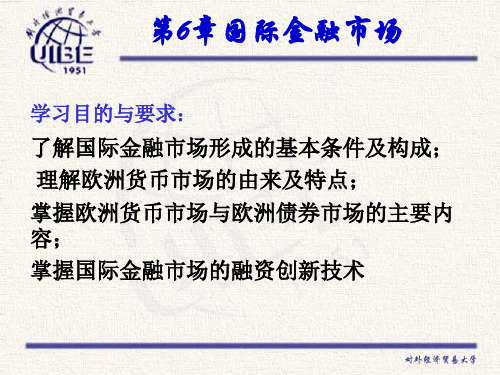国际金融第六章
- 格式:ppt
- 大小:1.10 MB
- 文档页数:57
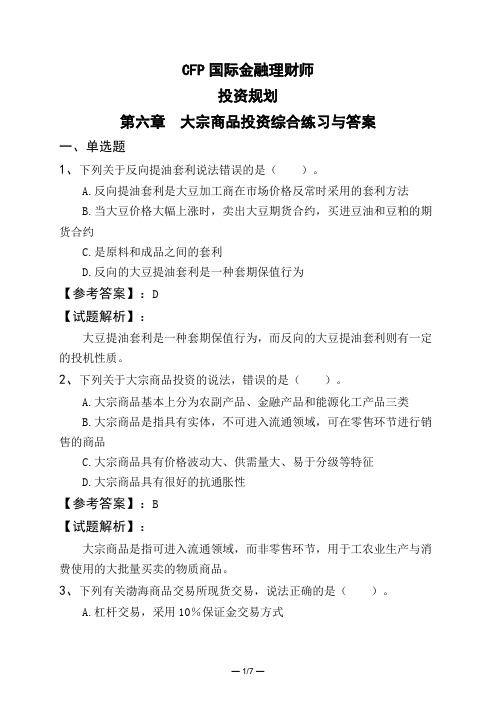
CFP国际金融理财师投资规划第六章大宗商品投资综合练习与答案一、单选题1、下列关于反向提油套利说法错误的是()。
A.反向提油套利是大豆加工商在市场价格反常时采用的套利方法B.当大豆价格大幅上涨时,卖出大豆期货合约,买进豆油和豆粕的期货合约C.是原料和成品之间的套利D.反向的大豆提油套利是一种套期保值行为【参考答案】:D【试题解析】:大豆提油套利是一种套期保值行为,而反向的大豆提油套利则有一定的投机性质。
2、下列关于大宗商品投资的说法,错误的是()。
A.大宗商品基本上分为农副产品、金融产品和能源化工产品三类B.大宗商品是指具有实体,不可进入流通领域,可在零售环节进行销售的商品C.大宗商品具有价格波动大、供需量大、易于分级等特征D.大宗商品具有很好的抗通胀性【参考答案】:B【试题解析】:大宗商品是指可进入流通领域,而非零售环节,用于工农业生产与消费使用的大批量买卖的物质商品。
3、下列有关渤海商品交易所现货交易,说法正确的是()。
A.杠杆交易,采用10%保证金交易方式B.通过大量的交易商集中撮合竞价,形成每日现货价格,具有很强的价格发现功能C.渤海商品交易所商品只涵盖石化,金属的专业领域D.只能在指定日期进行申请实物交割【参考答案】:B【试题解析】:A项,杠杆交易,采用20%保证金交易方式;C项,渤海商品交易所商品涵盖石化、金属、煤炭、农林等专业领域;D项,每日都可申请实物交割,给予现货商交割极大的便利。
4、交收系统使用费进行实物交收时,买卖双方同意按照()的标准向交易所支付交收系统使用费。
A.6元/吨B.7元/吨C.4元/吨D.5元/吨【参考答案】:D【试题解析】:交收系统使用费进行实物交收时,买卖双方同意按照5元/吨的标准向交易所支付交收系统使用费。
5、铜作为大宗工业原材料,被市场赋予的双重属性是指()。
A.商品属性和金融属性B.商品属性和货币属性C.商品属性和市场属性D.商品属性和工业属性【参考答案】:A【试题解析】:铜作为大宗工业原材料,被市场赋予双重属性:①本身所具有的商品属性,反映铜本身供求关系的变化对价格走势的作用;②衍生的金融属性,主要体现在利用铜进行投机、风险管理以及套利的市场行为。

国际公司金融习题答案第六章国际公司金融习题答案--第六章第六章课后练习参考答案1.什么是外汇风险,说明外汇风险的三种类型。
外汇风险,又称汇率风险,是指在国际经济、贸易和金融活动中,未来经营活动可能产生的以外币计价或计量的资产、负债、收入、费用和净现金流量的价值因汇率波动而产生的损失或收益的不确定性。
外汇风险主要包括交易风险、操作风险和会计风险。
2.试述三种外汇风险的区别。
交易风险是指已经发生的外币合同,其当前汇率与未来结算时的汇率之间的差异,导致相同金额的外币合同的成本货币按当前汇率与未来汇率折算的差异而产生的风险。
操作风险,又称经济风险,是指不可预测的汇率变动导致未来经营现金流量发生变化,从而导致企业价值变化的风险。
会计风险,又称折算风险,是指国际公司的母公司以本币编制母公司和子公司的合并财务报表时,以外币表示的外国子公司财务报表发生变化的可能性。
这三个区别如下:(1)重要程度不同。
营运风险是未曾预料的汇率变化对公司将来现金流量和公司价值造成的不确定性,会影响公司的生产成本、销售价格、市场竞争地位,对公司具有相对持久的影响,是最重要的风险。
交易风险是外币签订的合同价值受汇率变化影响,一般随着合同履行而结束,影响时间相对较短,影响程度相对不大。
而会计风险仅仅是外币报表折算过程产生的,相对更次要。
因此,国际公司在控制三种风险的时候,首先要确保规避营运风险,其次再考虑另外两种外汇风险。
(2)它反映在会计报表的不同位置。
汇率变动时,交易风险和会计风险能够随着会计报表的编制及时反映在报表中,汇率变动对公司经营风险的影响是长期的,可能会连续多年反映在会计报表中。
3.交易风险产生的来源有哪些?(1)以外币表示的应收账款和应付账款产生的交易风险。
①用外币表示的应收账款产生的交易风险②用外币表示的应付账款产生的交易风险(2)外币借贷过程中产生的交易风险①外币借款中的交易风险②外币放贷中的交易风险(3)开放式远期外汇交易产生的风险4.2021年3月1日,中国的a公司从日本的b公司进口一批产品,双方约定,货款用日元标价,金额为15000000日元,合同签订后3个月即2021年6月1日,a公司向b公司支付货款。
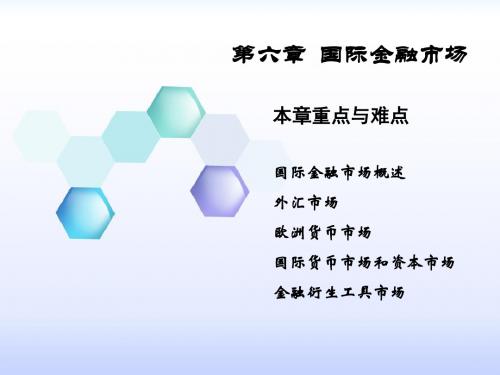
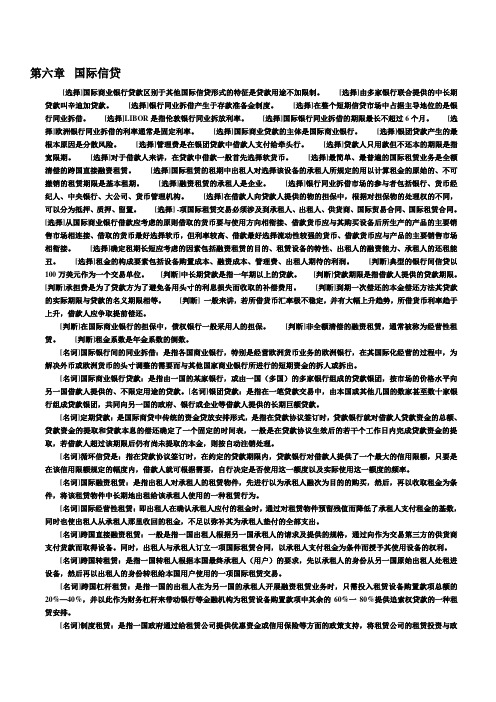
第六章国际信贷[选择]国际商业银行贷款区别于其他国际信贷形式的特征是贷款用途不加限制。
[选择]由多家银行联合提供的中长期贷款叫辛迪加贷款。
[选择]银行同业拆借产生于存款准备金制度。
[选择]在整个短期信贷市场中占据主导地位的是银行同业拆借。
[选择]LIBOR是指伦敦银行同业拆放利率。
[选择]国际银行同业拆借的期限最长不超过6个月。
[选择]欧洲银行同业拆借的利率通常是固定利率。
[选择]国际商业贷款的主体是国际商业银行。
[选择]银团贷款产生的最根本原因是分散风险。
[选择]管理费是在银团贷款中借款人支付给牵头行。
[选择]贷款人只用款但不还本的期限是指宽限期。
[选择]对于借款人来讲,在贷款中借款一般首先选择软货币。
[选择]最简单、最普遍的国际租赁业务是全额清偿的跨国直接融资租赁。
[选择]国际租赁的租期中出租人对选择该设备的承租人所规定的用以计算租金的原始的、不可撤销的租赁期限是基本租期。
[选择]融资租赁的承租人是企业。
[选择]银行同业拆借市场的参与者包括银行、货币经纪人、中央银行、大公司、货币管理机构。
[选择]在借款人向贷款人提供的物的担保中,根据对担保物的处理权的不同,可以分为抵押、质押、留置。
[选择] -项国际租赁交易必须涉及到承租人、出租人、供货商、国际贸易合同、国际租赁合同。
[选择]从国际商业银行借款应考虑的原则借取的货币要与使用方向相衔接、借款货币应与其购买设备后所生产的产品的主要销售市场相连接、借取的货币最好选择软币,但利率较高、借款最好选择流动性较强的货币、借款货币应与产品的主要销售市场相衔接。
[选择]确定租期长短应考虑的因素包括融资租赁的目的、租赁设备的特性、出租人的融资能力、承租人的还租能丑。
[选择]租金的构成要素包括设备购置成本、融资成本、管理费、出租人期待的利润。
[判断]典型的银行间信贷以100万美元作为一个交易单位。
[判断]中长期贷款是指一年期以上的贷款。
[判断]贷款期限是指借款人提供的贷款期限。


正保远程教育旗下品牌网站 美国纽交所上市公司(NYSE:DL)自考365 中国权威专业的自考辅导网站官方网站: 高等教育自学考试辅导《国际金融》第六章第二节讲义国际商业银行贷款一、国际银行、国际商业银行贷款及特点1.对国际银行概念的理解一家银行只要从事了跨国银行业务,就可以被称为国际商业银行。
2.国际商业银行贷款的概念国际商业银行贷款,是指由一国的某家银行,或由一国的多家银行组成的贷款银团,按市场的价格水平向另一国借款人提供的、不限定用途的贷款。
3.国际商业银行信贷的特点(1)贷款用途由借款人自己决定,贷款银行一般不加以限制国际商业银行在提供贷款时,一般要审查借款人的贷款使用方向,其目的是从贷款回收的角度进行贷款的可行性分析。
但借款人对所借款的使用方向,则完全由借款人自己决定,贷款银行不对其进行干预,一般也不附加任何条件。
(2)信贷资金供应较为充足,借款人筹资比较容易国际商业银行信贷资金的供应,特别是欧洲货币市场商业银行的信贷资金供应,一直呈增长的势头。
其主要标志是欧洲银行的各项存款科目总额,当然,并非所有的欧洲银行存款都会形成对企业的信贷资金供应,因为其中还包含了欧洲货币市场银行同业拆借部分。
(3)贷款条件由市场决定,借款人的筹资负担较重。
贷款的利率水平,贷款的偿还方式及其相对应的贷款实际期限和由贷款货币选择而决定的贷款汇率风险等,是决定借款人筹资成本高低的主要因素。
二、国际商业银行贷款的类型1.传统的国际金融市场的国际商业银行贷款传统的国际金融市场的国际商业银行贷款,是指由市场所在国的银行直接或通过其海外分行将本国货币贷放给境外借款人的国际贸易安排。
此时,作为国际商贷业务的主体——国际商业银行,客体——贷款货币,都要受到市场所在国法律及政府的管辖。
于是,并非所有国家的货币都可称为国际商贷的客体,也并非所有国家的商业银行都可从事这种业务。
事实上,只有少数经济实力比较强的国家,其货币成为国际支付和储备货币时,在这些国家中具有较强实力的银行才有可能开展国际商贷业务。

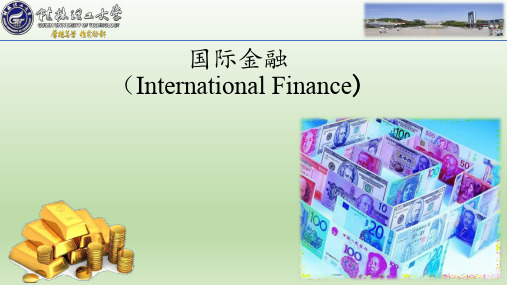
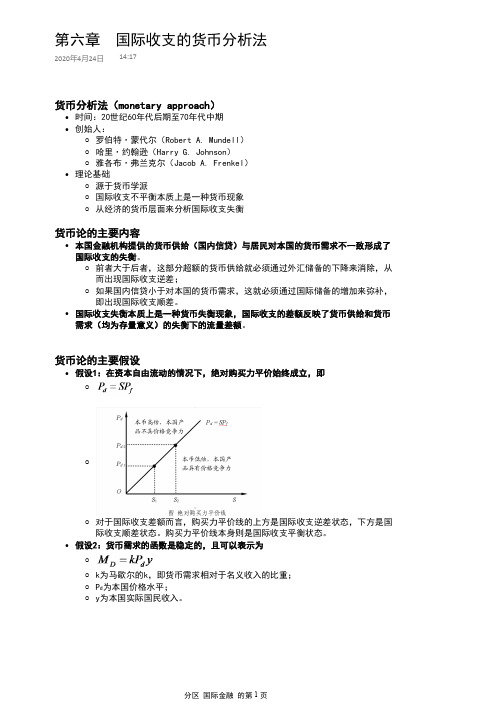
时间:20世纪60年代后期至70年代中期•罗伯特·蒙代尔(Robert A. Mundell)○哈里·约翰逊(Harry G. Johnson)○雅各布·弗兰克尔(Jacob A. Frenkel)○创始人:•源于货币学派○国际收支不平衡本质上是一种货币现象○从经济的货币层面来分析国际收支失衡○理论基础•货币分析法(monetary approach)前者大于后者,这部分超额的货币供给就必须通过外汇储备的下降来消除,从而出现国际收支逆差;○如果国内信贷小于对本国的货币需求,这就必须通过国际储备的增加来弥补,即出现国际收支顺差。
○本国金融机构提供的货币供给(国内信贷)与居民对本国的货币需求不一致形成了国际收支的失衡。
•国际收支失衡本质上是一种货币失衡现象,国际收支的差额反映了货币供给和货币需求(均为存量意义)的失衡下的流量差额。
•货币论的主要内容○○对于国际收支差额而言,购买力平价线的上方是国际收支逆差状态,下方是国际收支顺差状态。
购买力平价线本身则是国际收支平衡状态。
○假设1:在资本自由流动的情况下,绝对购买力平价始终成立,即•○k为马歇尔的k,即货币需求相对于名义收入的比重;○P d 为本国价格水平;○y为本国实际国民收入。
○假设2:货币需求的函数是稳定的,且可以表示为•货币论的主要假设第六章 国际收支的货币分析法2020年4月24日14:17□给定货币存量,在货币均衡条件下可得双曲线当货币供给数量增加,该曲线向右移动。
当曲线上的点从M移动到N时,名义国民收入Y不变,但同时意味着价格水平下降以及实际国民收入上升。
○○当出现技术进步使得劳动生产率提高时,总供给曲线会向右移动。
○假设3:总供给曲线垂直。
这意味着经济处于充分就业状态,国内物价上涨不会带来产出的增加•D为中央银行的国内信贷;○R为中央银行持有的国际储备;○假设4:本国名义货币供给为M S =D+R•通常认为,基础货币是流通中现金与存款准备金之和,即中央银行资产负债表的负债。

《国际金融》作业(10国商)第六章国际金融市场与衍生金融市场一、填空题1.传统的国际金融市场是指从事货币的国际借贷,并受市场所在国政府政策与法令管辖的国际金融市场。
2.外汇看跌期权指期权买方以一定的期权费为代价,获取在一定的期限内按照双方商定的协议价格一定数量外汇的权利或该权利。
3.外汇期货交易的制度和制度,可以使清算所不必顾及客户的信用,减少了期货交易中的违约风险。
4.外汇期货交易中的套期保值是指人们在现货市场和期货交易上采取的买卖行为。
5.在互换交易中占主要地位的两种互换交易是和。
6.买入美元看跌期权的买方是预测美元汇率未来将要。
7.如果A公司以固定利率筹资有比较优势,B公司以浮动利率筹资有比较优势,则A 以利率筹资,B以利率筹资;进行利率互换后,A实际上是以利率筹资,B实际上以利率筹资。
8.期权交易的买方收益是的,损失是的,而期权交易的卖方收益是的,损失是的。
9.狭义的国际金融市场指在国际间经营资本的市场,包括市场和市场。
10.离岸金融市场的特点在于经营对象是货币,市场行为以交易为主体。
11.根据债券发行人、面值货币、发行市场三者的关系可将国际债券分为债券和债券。
12.欧洲货币市场既存在短期信贷的市场,也存在长期信贷的市场。
13.衍生金融工具交易的显著特点是它具有比例,即金融合约价值可以多倍地高于保证金价值。
14.期货保证金是买卖外汇期货合约的信用保证,又分为保证金和保证金。
15.先卖出期货后买进期货称为套期保值;如果先买入期货,后卖出期货,则为套期保值。
二、判断题(用T表示正确、F表示错误)1.()外汇期权交易直接买卖的是外汇,期权合约的价格指的是外汇交割时所使用的执行价格。
2.()外汇期货交易的报价实行双向报价法,交易双方既报买价又报卖价。
3.()看涨期权的买方在交割日的即期汇率大于协定汇率的时候执行期权,并且一定获利。
4.()代表期权价格的期权费的大小取决于期权的时间价值和内在价值。

第六章作业1.为什么需要进行汇率预测模型的检验?常用的检验方法有哪些?答:无论是运用基础因素分析法还是市场分析法,由于这些方法自身的局限性,得到的预测结果总会在一定程度上偏离实际值。
偏差越大意味着预测的准确性越差,预测的结果有效性越低。
为了确保预测的准确性,以便为外汇风险管理提供科学依据,我们必须对所采用的汇率预测方法或者预测模型进行检验,选择偏差最小的预测方法,采用预测效果最佳的模型。
常用的检验方法有:基础因素预测法和市场预测法。
2.你如何看待汇率预测出现的误差问题?如何调整预测的系统偏差?答:无论采用何种方法建立的模型都会存在一定的误差。
不同的模型预测误差大小也不相同。
除了运用散点图直观地粗略地判断预测模型外,我们还可以通过计算误差的方法来度量,比较模型的预测误差。
一般情况下,置信度为95%就是可以接受的。
如果要求不那么高,在一些特殊情况下,90%的置信度也是可以接受的。
调整步骤:(1)用预测模型求得一组预测值(2)计算预测值与实际值的相关系数,并进行参数检验(3)计算具体的系数偏差(4)根据预测的系统偏差进行预测值调整。
3.币值变化和货币相关关系给涉外企业会带来哪些交易风险?答:(1)本国货币升值带来的经济风险:①对跨国公司本币流入类业务的影响。
本国货币升值可能导致跨国公司在本国的销售收入减少,以本币标价的出口现金流入量可能减少,以外币标价的出口也可能出现现金流入量减少,②对跨国公司本币流出类业务的影响。
本币升值给跨国公司的现金流出类业务带来的经济风险正好与现金流入类业务相反,会同时导致跨国公司现金流入量和流出量的减少。
(2)本国货币贬值带来的经济风险:①对跨国公司本币流入类业务的影响。
由于本币贬值,从外国进口的商品的本币价格上升,使跨国公司在本国市场的竞争力增强,以本币标价的出口现金流入量增加,以外币标价的出口本币现金流入量增加,②对跨国公司本币流出类业务的影响。
以本币标价的进口现金流出量不会直接受到汇率变动的影响,然而以外币标价的进口成本会增加,外币融资利息支出的本币成本也会增加,总之本币贬值导致现金流入量和流出量同时增加。
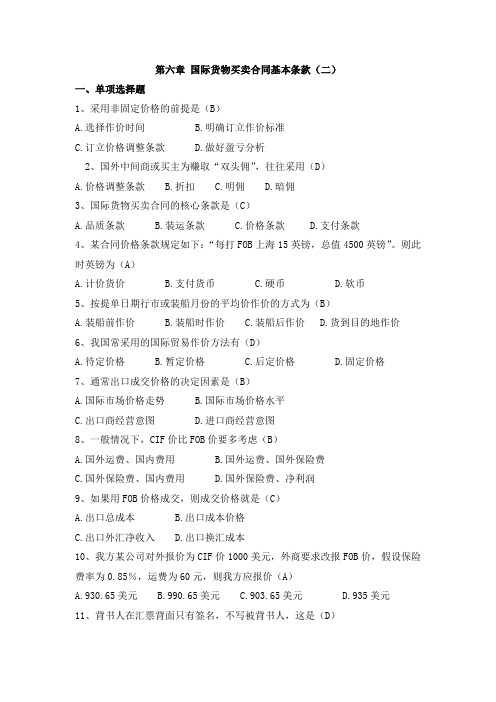
第六章国际货物买卖合同基本条款(二)一、单项选择题1、采用非固定价格的前提是(B)A.选择作价时间B.明确订立作价标准C.订立价格调整条款D.做好盈亏分析2、国外中间商或买主为赚取“双头佣”,往往采用(D)A.价格调整条款B.折扣C.明佣D.暗佣3、国际货物买卖合同的核心条款是(C)A.品质条款B.装运条款C.价格条款D.支付条款4、某合同价格条款规定如下:“每打FOB上海15英镑,总值4500英镑”。
则此时英镑为(A)A.计价货价B.支付货币C.硬币D.软币5、按提单日期行市或装船月份的平均价作价的方式为(B)A.装船前作价B.装船时作价C.装船后作价D.货到目的地作价6、我国常采用的国际贸易作价方法有(D)A.待定价格B.暂定价格C.后定价格D.固定价格7、通常出口成交价格的决定因素是(B)A.国际市场价格走势B.国际市场价格水平C.出口商经营意图D.进口商经营意图8、一般情况下,CIF价比FOB价要多考虑(B)A.国外运费、国内费用B.国外运费、国外保险费C.国外保险费、国内费用D.国外保险费、净利润9、如果用FOB价格成交,则成交价格就是(C)A.出口总成本B.出口成本价格C.出口外汇净收入D.出口换汇成本10、我方某公司对外报价为CIF价1000美元,外商要求改报FOB价,假设保险费率为0.85%,运费为60元,则我方应报价(A)A.930.65美元B.990.65美元C.903.65美元D.935美元11、背书人在汇票背面只有签名,不写被背书人,这是(D)A.限定性背书B.特别背书C.记名背书D.空白背书12、受益人开立远期汇票但可通过贴现即期足额收款的信用证是(C)A.即期信用证B.远期信用证C.假远期信用证D.预支信用证13、国际货物买卖中,商业发票的抬头是(A)A.申请人名称B.受益人名称C.受让人名称D.开证行名称14、通过汇出行开立的银行汇票的转移实现货款支付的汇付方式是(C)A.电汇B.信汇C.票汇D.银行转帐15、我国中国银行签发的汇票有效期大都规定为(B)A.半年B.一年C.二年D.随汇款人意愿而定16、信用证方式下,愿意买入受益人交来跟单汇票的银行是(A)A.议付银行B.通知银行C.保兑银行D.偿付银行17、银行保证书属(C)A.商业信用B.国家信用C.银行信用D.信贷保险18、进出口业务中,买方远期信用证又可称为(C)A.转开信用证B.银行承兑远期信用证C.假远期信用证D.即期信用证19、接受汇出行的委托将款项解付给收款人的银行是(B)A.托收银行B.汇入行C.代收行D.转递行20、国际货物买卖中,C.W.O.表示(A)A.随订单付现B.交货付现C.交单即付D.延期付款21、在汇付方式中,能为收款人提供融资便利的方式是(B)A.信汇B.票汇C.电汇D.远期汇款22、保兑行对保兑信用证承担的付款责任是(A)A.第一性的B.第二性的C.第三性的D.第四性的23、在采用信用证方式预付货款时,通常是用(C)A.跟单信用证B.保兑信用证C.光票信用证D.远期信用证24、如果出票人想避免承担被追索的责任,也可以在汇票上加(C)A.付一不付二B.见索即偿C.不受追索D.单到付款25、信用证支付方式实际上把进口人履行的付款责任,转移给(B)A.出口人B.银行C.供货商D.最终用户26、远期付款交单条件下,进口人凭以借取货运单据并先行提货的单据是(B)A.保兑单据B.信托收据C.加押电报D.解付收据27、承兑人对出票人的指示不加限制地同意确认,这是(A)A.一般承兑B.特别承兑C.普通承兑D.限制承兑28、商业汇票的出票人和受票人一般是(B)A.银行进口人B.出口人进口人C.银行银行D.进口人进口人29、下列各项中,不是汇付方式当事人的是(D)A.汇款人B.汇出行C.解付行D.提示行30、D/P.T/R意指(C)A.付款交单B.承兑交单C.付款交单凭信托收据借单D.承兑交单凭信托收据借单二、多项选择题1、在核算由中间商参与交易的出口商品价格时,国外费用一般包括(CDE)A.进货成本B.证件费用C.国外运费D.国外保险费E.佣金2、按CIF条件成交,卖方报价中应包括(ABCDE)A.进货成本价B.国内费用C.国外运费D.国外保险费E.净利润3、在确定出口成交价格时,应考虑的具体因素是(ABCDE)A.商品的质量和档次B.成交量C.运输距离D.交货地点和交货条件E.支付条件4、CIF价的构成要素是(ABCDE)A.进货成本价B.国内费用C.国外费用D.国外保险费E.净利润5、目前价格调整条款的使用范围是(CD)A.劳务商品交易B.加工商品交易C.机械设备交易D.初级产品交易E.包销交易6、在我国进口业务中,FOB、CFR和CIF三种主要术语的价格构成包括(ABCD)A.进货成本B.国内费用C.净利润D.国外费用E.毛利润7、在核算出口商品价格时,国内费用主要包括的项目是(ABCDE)A.加工整理费用B.包装及保管费用C.国内运费及装船费用D.邮电费及证件费E.银行费用和预计损耗8、CIPC3%所涉及的国外费用通常有(ABC)A.国外费用B.国外保险费C.佣金D.银行费用E.证件费用9、正确运用佣金对我国进出口业务的作用有(ABCE)A.有利于灵活掌握价格B.调动中间商经营我产品积极性C.扩大销售D.照顾老客户E.增强有关货物在国外市场竞争力10、价格修正条款调整价格的依据有(AC)A.工资的变动B.管理费的变动C.原材料价格变动D.利润的变动E.保险费用的变动11、对于成套设备、大型机械产品和交通工具的交易,一般采用的清偿货款的方式是(AB)A.分期付款B.延期付款C.信用证D.托收E.汇付12、下列各项中,有关保证书叙述正确的有(ACDE)A.又称保函B.有条件保函的保证人承担第一性的付款责任C.分为见索即付保函和有条件保函D.见索即付保函的担保人承担第一性的付款责任E.保证书英文缩写为L/G13、备用信用证最早流行于(DE)A.中国B.法国C.英国D.美国E.日本14、本票与汇票的区别在于(ABCDE)A.前者是无条件支付承诺,后者是无条件的支付命令B.前者的票面当事人为两个,后者则三个C.前者在使用过程中无需承兑,后者则有承兑环节D.前者的主债务人不会变化,后者的主债务人因承兑而发生变化E.前者只能一式一份,后者可以开出一套15、汇付包括(AC)A.D/DB.D/PC.M/TD.D/AE.T/T15、对汇票的受款人承担保证汇票被承兑和付款的责任的汇款当事人是(AC)A.出票人B.受票人C.背书人D.受让人E.前手16、出口商必须在付清货款后才能取得货运单据,这种结算方式是(BC)A.光票托收B.即期付款交单C.远期付款交单D.付款交单凭信托收据借单E.承兑交单17、一份信用证的基本内容,其中要在受益人提供的单据中表示出来的项目有(BCDE)A.对信用证本身的说明B.对货物的要求C.对运输的要求D.对单据的要求E.特殊要求18、进出口业务中,退票行为主要有(ABCDE)A.拒绝承兑B.拒绝付款C.付款人不见汇票D.付款人死亡E.付款人宣告破产19、在信用证项下,如使用汇票应明确(ABCDE)A.出票人B.受票人C.汇票金额D.汇票期限E.主要条款20、一张汇票,可以是一张(ABCD)A.即期汇票B.跟单汇票C.商业汇票D.银行承兑汇票E.支付承诺三、判断题1. 在国际贸易中,达成一项交易的两个必不可少的环节是发盘和接受。
